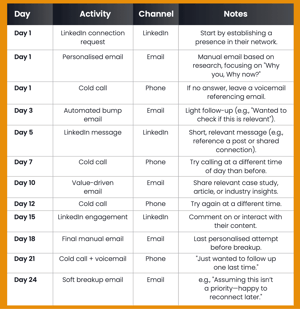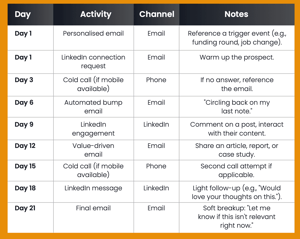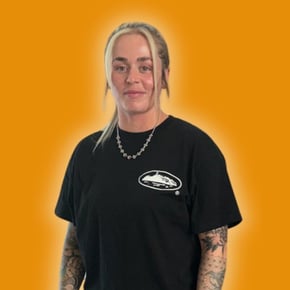Sales Cadence Examples That Actually Work in 2025
Gone are the days of “spray and pray” outreach. In 2025, the best sales cadences are intentional, data-driven, and hyper-relevant to your buyer. Whether you’re an SDR/BDR breaking into new accounts or an AE managing a book of business, a strong outreach cadence is your tactical playbook for starting real conversations. But it’s not just about hitting touchpoints. It’s about hitting the right ones, in the right order, with the right message.
Let’s break down what a sales cadence is and why a solid cadence matters more than ever. Then we will give you some actual sales cadence examples and templates that are working now.
This article is part of sales prospecting 'How to Win at Prospecting in 2025'. Learn all about cold emails that work, cold calling, and effective sales messages.
What Is a Sales Cadence?
Before we dive into sales cadence examples, let’s get clear on what a sales cadence actually is—and why it matters.
A sales cadence is just a structured series of outreach steps reps follow to engage leads. Think of it as your playbook for turning a hand-raiser or cold lead into a conversation. That could mean sending a personalised email, following up with a cold call, then connecting on LinkedIn—all spaced out over days or weeks.
Whether you’re running a B2B sales cadence or a fast-moving transactional process, cadences keep your team aligned, your funnel moving, and your follow-ups consistent.
Why Sales Cadences Work
The best sales cadences aren’t random—they’re repeatable. They keep your pipeline from leaking by:
- Giving reps a clear roadmap to follow
- Making activity easy to track, test, and improve
- Reducing friction and speeding up conversions
- Scaling with your team as your outreach grows
Modern outreach cadences also rely on more than one channel. At a minimum, you should be using email, phone, and social to get on your buyer’s radar. The best outbound sales cadence combines all three for maximum visibility.
A digital sales cadence might lean more into email and social, while an outbound sales cadence often starts with a cold call and works in personalised touches from there. Regardless of the format, the key is structure—sequential, relevant, and persistent outreach.
From email cadence examples to full-blown prospecting cadences, the goal is the same: build consistent, high-quality touchpoints that move leads forward.
Why Is a Sales Cadence Important?
The way we prospect has changed, fast. AI is flooding inboxes, buyers are filtering harder, and generic outreach is toast. That’s why top reps in 2025 are going all-in on well-structured cadences.
Charlotte Johnson from Salesloft puts it best:
“Prospecting in 2025 requires a more strategic approach, and account segmentation is key to managing time and efforts effectively. I categorise accounts into three buckets: Tier 1 for high-value accounts that demand extensive research and longer engagement, Tier 2/3 for good-fit, average-size deals that can be approached more quickly, and Signals for intent-driven accounts that offer quick wins.”
She continues:
“For Tier 1 accounts, I take a strategic, time-intensive approach, combining extensive research, internal insights, and leveraging common connections for introductions… This method ensures I’m not just filling up cadences but engaging in meaningful, personalised outreach that aligns with the company’s priorities.”
That’s the mindset shift. Sales cadences aren’t just about “following up.” They’re about building a journey that meets your prospect where they are.
Sales Cadence Best Practices
If you’re building or refining your sales outreach cadence, here are the core principles every rep should lock in.
1. Cold Calling Still Converts
Don’t let the digital noise fool you—cold calling is still the highest-converting channel, especially in B2B sales cadences. Make it part of your outreach cadence and pair it with other touchpoints for maximum impact.
Cat King, Outbound Success Coach at MySalesCoach:
“The phone is still very much king. Your cadence should have calls as part of the sequence.”
2. Front-Load, Then Space Out
So, how long should a sales cadence last? The best outbound sales cadence doesn’t just hammer for a few days and disappear. It builds momentum early, then stretches touchpoints over 21–27 days. That balance keeps you top-of-mind without getting muted.
3. Relevant Personalisation Wins
Mentioning their dog’s name from LinkedIn might feel personal—but if it’s not relevant to your value prop, it’s just fluff. One big mistake is overloading an email with too much personalisation that isn’t relevant.
4. Multi-Channel Sales Cadence Strategy Beats Single Channel
Cadences sales leaders love are multi-threaded. That means emails, calls, social, and video all play a part in your cadence strategy. For some personas, it’s LinkedIn. For others, it’s email or phone. Align your outreach cadence with where your ICP actually lives.
5. Use the 'Power of Three' Early
Early touches are critical. Stack three different outreach types—like a LinkedIn request, a personalised email, and a cold call—right out of the gate.
Kaitlen Kelly, Sales Leadership and Outbound Coach at MySalesCoach
“Start with a LinkedIn connection, a personalised email, and a cold call to maximise initial engagement.”
6. Measure and Adapt Based on Data
Too many teams give up or pivot too fast. Run your cadences with 200–300 prospects before tweaking.
Data > gut.
The hallmark of a good cadence is measurement. Without data, you’re just guessing.
7. Build a Playbook for Consistency
Consistency in messaging across reps gives you cleaner data and scalable results. The best sales cadences come from playbooks that reps can follow and improve—not reinvent every time.
Outbound SDR/BDR Cadence Example (Cold Outreach, 13 Touchpoints over 21-27 days)
Here’s a real-world outbound sales cadence template designed for BDRs/SDRs focused on cold outreach.
It uses 13 touchpoints over 21–27 days and follows the 'Power of Three' framework.
This is the kind of outbound sales cadence that builds pipeline without burning bridges. It’s intentional, multi-channel, and persistent—without being spammy.
Goal: To break into net-new accounts efficiently while maintaining a personalised and relevant approach.

AE Cadence Example - (Hybrid Prospecting, Adjusted for Time Constraints, 10 Touchpoints over 21 Days)
AEs are juggling more than just prospecting, so their sales cadence has to work with time constraints. This example shows a hybrid approach with 10 touchpoints over 21 days.
This sales cadence is perfect for mid-funnel AEs working named accounts. It keeps outreach tight, meaningful, and manageable.
Goal: To balance outreach with other sales responsibilities while focusing on high-priority prospects.

Final Thoughts
Whether you’re building your first prospecting cadence or optimising an existing one, the rules in 2025 are clear:
- Mix your channels
- Stay relevant
- Be persistent—but human
- Follow the data
The best sales cadences don’t feel like cadences. They feel like conversations. Start there, and you’ll stop chasing replies—and start getting real ones.
Our Prospecting learning path covers everything you need.




.png?width=300&name=Copy%20of%20Untitled%20Design%20(1).png)